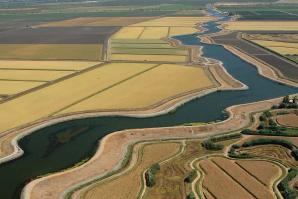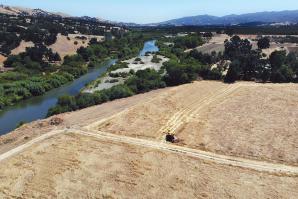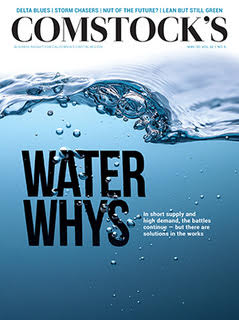Professor Jennifer Harder is the co-director of the Water & Environmental Law program at McGeorge School of Law in Sacramento. Prior to becoming a full-time professor in 2015, Harder practiced law for a decade as an attorney and partner with Downey Brand in Sacramento. Comstock’s spoke with Harder about water issues affecting the Capital Region and California.
How do California’s complicated water rights affect our daily lives?
California is an arid state that experiences regular cycles of drought and flood. In addition to the variable hydrology, we also have a mismatch in the state between where the water originates and where the people live. Most of our water originates in the northern parts of the state and in the eastern Sierra, and most of the people live in Southern California and along the coast. So we need to address several kinds of scarcity — annual scarcity, seasonal scarcity and geographical scarcity — and we know we have all these different needs for water … urban and ag and commercial and institutional and hydropower and environmental and recreation.
Water rights are the rules by which we decide how much water gets delivered to which part of the state, and which of those uses gets allocated how much water. … This is directly relevant to people when you go to turn on your tap, how much water comes out, how clean that water is, whether you have sufficient water to irrigate your landscaping, to run your business, to grow food and fiber — water rights determine all of these things.
Your courses focus on “policy implications of legal rules and skills needed for real world practice.” What does that mean?
Every legal rule implements a policy choice. It implements some underlying value. An example of this is one of the key water rights in California is called an appropriative water right. Appropriative rights are allocated based on the rule of priority, which means the person who diverted water first has the best right to the water. We call that the principle of “first in time, first in right.”
This is one of the oldest rules in California. It goes back to at least 1855, perhaps older, shortly after California became a state. This rule — first in time, first in right — is grounded in a policy, it’s grounded in a value choice, and that policy was to encourage people to invest in projects that will translate natural resources into social values, into social good.
For example, in the early 20th century, you had hydropower companies that were investing in construction of reservoirs and construction of other systems to move water to generate electricity that then fueled the growth of our cities and the city economies, which provided public benefits and supported improved quality of life in California. But at the same time, California has a constitutional water policy, (which) mandates that all water be used reasonably — the rule of reasonable use — and to the fullest extent possible. … It recognizes the scarcity of water in California.
These rules implement other policy choices, other values, that favor broad distribution of water and putting water to its highest and best use, regardless of underlying priority. So this gives us the flexibility to change water allocation when we need to. So, you can see, we have these legal rules but they reflect underlying policies, underlying values and so when I teach about water and water rights, I want people to recognize that the rules themselves aren’t as important as the choices we’re making.
California’s water laws are based on the need to balance various objectives — safe and reliable human consumption, environmental needs, recreational needs, business and industry needs. Would you say our laws are achieving this balance?
The California Constitution says we must maximize scarce water resources and that water allocation requires balancing — environmental, economic, social, technical. The law that we find in the constitution, in our water code, in the court cases that deal with water, they provide all the tools that we need from a legal perspective to accomplish the balancing. The law requires balancing, … and when water allocation is out of balance, this is usually attributable to the combined influence of our political system, the structure of our government institutions, funding issues and, ultimately, human behavior.
It’s also important to understand that balancing is a bit of a misnomer. Human needs and desires are so diverse that when our decision makers — that’s either the state Water Resources Control Board, the state agency under the California Environmental Protection Agency, or a court — make a decision, we have so many desires and needs and a relative scarcity of water for certain years and certain times of years that somebody is always going to be aggrieved by the outcome. So when we say balancing, we don’t mean 50-50 outcomes, we mean that social values benefits that are supported by water have all been considered, and our accountable government institutions have made a choice about which social values to favor. …
Because balancing is done by political institutions, it’s imperative that these institutions … reflect the diversity of needs and perspectives in our state. Good decisions about water depend on inclusiveness in leadership in these institutions, inclusiveness in our elected officials and appointments at all levels of government (and) in our private institutions.
How did the historic drought of 2012-14 change the conversation related to water in California?
One of the things we have not done very well in this state is to talk about water when we are not in a state of crisis. … We need to remember that drought is not an exceptional occurrence in California. Because of our Western climate, most of the current population couldn’t live or work in most areas of the state without our reservoir system to store water and systems that move water.
In this state, in this arid climate, our cycles of drought and flood are completely normal. It’s expected that in dry years and dry seasons you’re just not going to have enough water coming down from the mountains as snowmelt, into the rivers and into the groundwater basins, to serve all of the needs. But we have so many different needs in the state — drinking water for health and safety, economic health, jobs, housing, food, enviro, recreation, ecosystems, biodiversity, the list goes on. We need to understand that we can’t be reactive just during drought, we need to be planning for drought during times of plenty.
Historically, some of the biggest changes have come during drought periods because we see it as a crisis and that brings energy to political leadership. A couple of examples that came out of the last drought include the Sustainable Groundwater Management Act of 2014, which was a historic event to bring a statewide perspective to groundwater management that had previously been missing. Another example is there is more attention on the plight of disadvantaged communities who lack the infrastructure and funding needed to have a safe, reliable, accessible water supply. So those two accomplishments are laudable. We’re also moving in the direction of better planning around conservation and efficiency.
What is the biggest domestic water law issue we’re facing in California?
If I had to pick one, I would say addressing climate change. Climate change has a number of implications — rising temperatures, decreased snowpack, shorter and more intense wet seasons, changes in precipitation, sea-level rise — (that) are already affecting water management in California. We have less snow and earlier snowmelt and higher winter runoff, essentially warmer and more intense droughts, so we need to be thinking differently and planning differently. But our current water infrastructure is not … able to accommodate this level of change.
Most of our reservoirs were built more than 50 years ago, and they were designed for the past hydrology, not the hydrology with climate change. So we need to do a number of things. One key thing is to increase storage in our groundwater basin. We also need to invest strategically in infrastructure improvements and make better use of technology. … We also need reliable sources of funding, and that is going to require addressing challenges in funding mechanisms at the local level, and increasing state funding as well.
I would say there are two other major issues. One is drought preparedness. One of the conversations that is occurring right now is around bills (Assembly Bill 1668 and Senate Bill 606) that were adopted in 2018 to increase conservation and efficiency. These laws directed our state Water Resources Control Board to adopt long-term standards for efficient water use by June of 2022. This overall framework requires our water supplies to achieve a standard of indoor water use of 55 gallons per person per day, which will drop incrementally to 50 gallons beginning in 2030.
One of the things that we have not done very well in this state is to talk about water when we are not in a state of crisis. … We need to remember that drought is not an exceptional occurrence in California. … We need to understand that we can’t be reactive just during drought, we need to be planning for drought during times of plenty.
One of the interesting things here is the role that rumor and inaccurate portrayals in the media play in people’s understanding (of these laws). Some people believe that people are going to be limited to 55 gallons per day in their home and will have to dramatically cut — we always want to encourage conservation and efficiency in the home; conservation as a way of life is important. But the fact is the way this is going to work is the 55 gallons per person per day will be an average across the water supplier, and there’s a number of ways to achieve that, including addressing efficiencies with outdoor residential water use, decreasing water loss due to leaks. … (This) will result in an overall water use target per supplier, not per household. …
One of the related conversations that we had in the last drought that we’ll have to tackle going forward … is how we regulate water suppliers around the question of conservation. During the last drought, conservation standards were imposed on water suppliers, they were tiered water conservation targets, but they weren’t adjusted based on prior investment of the local water suppliers in water conservation. So one of the things we’re doing now is hoping to connect the prior investments in water conservation to the required conservation standards going forward.
The other issue … I would highlight is our challenges to reach agreement on the amount of flow that should stay in-stream in river systems to protect ecosystems and species and water quality. In-stream flow wasn’t a substantial consideration in our initial water allocations in the state. We now have a better understanding of how important healthy ecosystems are to our own health and to support our economy and our own quality of life.
We need a healthy environment, dynamic functioning ecosystems, high water quality — these are economic investments. They’re business assets as much as they are about valuing the idea of environment, which is (also) important. So the challenge we have is much of the available water in the state has already been claimed in one way or another over the decades, so the state as a whole is in the midst of a slow and often challenging process to figure out how to shift water use to achieve a better allocation between the two, taking a long-term view that accounts for climate change, increasing population and other challenges we will see in the future.
We’re in a housing crisis in California. How do we balance water conservation with the need for residential development?
We already have robust laws in the state that connect land-use planning to water supply. These are known as the “show me the water” laws, (Senate Bill) 610 and (Senate Bill) 221. … We’re constantly improving the implementation of those laws. … There are other things we can do to ensure we have sufficient water. One is to improve the efficiency of our existing water use, not only to do things like reducing leaks and adopting systemwide conservation standards, but also to maximize the use of our existing water resources by investing in alternative water supplies, supplemental water supplies, like recycled water, for example, (or) groundwater banking.
There are also a couple innovative approaches in thinking about housing and water. One of these is called water neutral programs or water demand offset management. These are (local) ordinances that require new developments to identify a secure water source (and) to mitigate or offset their increased water demand by investing in, for example, a project to bring more recycled water into the area or investing in water conservation in an older neighborhood where people have not had the incentive to replace their old fixtures. A number of jurisdictions did this during the drought in the late ’80s and early ’90s, and more did it in our last couple of droughts. … This is the kind of thing that should be getting more attention during this period of relative plenty while we wait for the next drought.
How is legal recreational cannabis in California affecting water in the state?
When legalization was coming down the road, our regulatory agencies realized they needed a method for ensuring that this activity … doesn’t unduly affect our water quality and environment, both for human health and safety needs, and to support environmental values. The state water board has adopted principles and guidelines for cannabis cultivation. It essentially requires cannabis (growers) to register (in the) Small Irrigation Use Registration system, which is a method for ensuring that cannabis (growers) will cease diversions of surface water during dry seasons and to facilitate and expedite the development of storage facilities, so that the cultivators will continue to have water supplies during those dry seasons.
The cannabis program at the state water board has also involved a general order that attempts to provide a simplified path through our water quality system. … The other piece of all this is that the cannabis principles and guidelines provide best practices for cultivators to try to avoid those impacts, related to things like riparian and wetlands protection, water diversion and storage, irrigation runoff, erosion control, drainage, soil disposal, stream crossings, pesticides and herbicides applications, essentially to provide guidance so we can balance this important part of our business sector but also protect human health and safety and water quality and the environment.
What are the major issues affecting the Sacramento-San Joaquin Delta and how does water law tie into that?
The Delta is usually identified as California’s most long-standing and, so far, most intractable issue. There’s been a decadeslong effort to address issues related to protection of water quality, protection of listed species and habitat, and protection of agriculture and communities in the Delta. The Delta serves as a hub for our major projects that move water between the places where the water originates and the places where the people live in California — these are the California State Water Project and our federal Central Valley Project.
They support millions of people with drinking water, hydropower generation and … agriculture. … The federal Central Valley Project was initiated in the 1930s, … the State Water Project came along in the 1960s. Even at their inception, these projects were the subject of controversy because of the very fact that they moved water around the state. The Delta is … below where the water originates but above where most of the people live, so the water from the projects has to flow through the Delta.
The operations of (these two) projects have improved the Delta water availability in some respects during some seasons. In other ways, it has caused injury to species and water quality in the Delta. The bad has been significant enough to result in the listing of certain fish species as endangered … and decreased water quality. Those problems existed from the beginning. As population grows, which exacerbates the effects of drought and climate change, we see ever-more increasing attention on the Delta.
Likewise, the infrastructure is in deep need of repair in many parts of our state water project and federal water project systems. So the Delta has seen many major reform proposals over the decades. We’ve known these by various names: It’s been the Peripheral Canal, the Bay Delta Conservation Plan, the (California) WaterFix are (what) people call the Delta tunnels, and (the) Delta Conveyance is the most recent iteration. One of the key focuses for reform in all of these projects has been to decrease the impacts of pumping plants, which are located in the south Delta. Cal WaterFix … had proposed to install new intake facilities in the north Delta and route project water through conveyance facilities that would either go around or through the Delta, and also include through-Delta flows at the same time, so we called it “dual conveyance.”
These conveyance changes were intended to decrease fish entrainment in the pumps — fish getting caught in the pumps — and to lessen the water quality impacts of project operations. … During the California WaterFix planning, there was significant discussion between the water and environmental communities about the possibility of downsizing the project to only one tunnel, which would reduce the impacts and costs.
When Gov. (Gavin) Newsom took office in 2019, he released the Water Resilience Portfolio, out in draft now, which essentially settles on a one-tunnel direction for the project. He subsequently issued an executive order directing the state agencies to take the necessary steps to shift to the one-tunnel approach. That’s what we call Delta Conveyance, which is currently undergoing environmental review.
Anything else you’d like to mention?
I wanted to highlight the work that’s being done around the human right to water and ensuring more water for disadvantaged communities. … California was the first state to adopt regulation to declare a human right to water (in 2012). While that didn’t have a direct affect on the allocation of water rights or the obligation of water suppliers, it has incentives and encourages our state and local agencies to pay more attention to this issue.
The primary issue with ensuring that all people have a safe and reliable affordable supply of water doesn’t have to do with water rights themselves but with ensuring that communities have the ability to store, treat and deliver water. The state water board has had a number of accomplishments in helping to facilitate this improvement in infrastructure and funding mechanism to ensure these communities have access to water. …
In 2019, the state adopted a new funding mechanism that will provide state money toward improving infrastructure in these systems. There’s more to do in this regard. Related to that, I wanted to highlight this need for ensuring that in our state we have many different government entities that are engaged in providing water, these include urban water supplies and agriculture water suppliers. These are all public agencies, and … the makeup of these institutions really needs to reflect the diversity in our state to ensure that we have a diversity in perspective.
—
Get stories like this delivered directly to your inbox: Subscribe to the Comstock’s newsletter today.
Recommended For You

Delta Blues
The battle over water has been fought to a standstill, but there’s hope that science and technology will make voluntary agreements by all sides possible
For decades, the California water debate revolved around one metric: unimpeded flow, which is the amount of water in the river and streams. While flow is still without doubt the key issue, it is no longer the only one.

Shouldering the Burden
Progressive-minded farmers in the Capital Region undertake steps to battle and adapt to climate change
A growing movement of farmers is focused on agricultural practices that can mitigate or adapt to an uncertain future brought by climate change.
Part of this month’s Innovation issue




